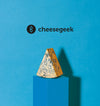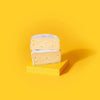Why is blue cheese blue?
By Livvie Newman
Oct 3, 2023

Why is Blue Cheese blue?
Blue cheese. Perhaps the most divisive of all the cheese styles out there. A type of cheese that people really, really like, or really, really don’t.
So, what is blue cheese? And why, why, why is it blue?
What is it?
Cheese…
Sorry, sorry! We actually shouldn’t be so glib. Blue cheese dates all the way back to the 7th century, to a cave outside of a village in France. The legend goes that beautiful blues came to be because a shepherd seeking shelter from bad weather in a cave, became distracted by an attractive passer by and forgot his cheese sandwich. Upon his return a few months later, his forgotten cheese had morphed into something new thanks to moulds that had spread from the bread - the very first Roquefort! (FYI Roquefort is still made using moulds grown on Sourdough, cultivated in the Combalou caves in Roquefort-Sur-Soulzon, France).
Now, this story could easily be considered to be an old wives’ tale, but within it lies the truth of what blue cheese actually is. To put it simply, blue cheese is cheese that has been inoculated with the bacteria penicillum roqueforti which is then exposed to oxygen.
Blue cheese is the most challenging style of cheese to make as it requires high moisture levels, and the introduction of particularly high levels of moulds and microbes. It means there is an awful lot more that can go wrong during the make, and ageing process.
But, why is it blue?
Well that’s the penicillum roqueforti! When the paste of the cheese gets exposed to oxygen, the blue veining develops and grows through any gaps and folds in the cheese. This is why the curds tend to be relatively lightly pressed, if at all, when blue cheese is being made. As you want to leave plenty of space for the blue mould to spread and impart flavour into the cheese.
This veining is what gives most blue cheeses their distinctive salty and complex flavours!
In modern cheesemaking, the mould growth is activated by piercing the cheeses with stainless steel rods at around 3-6 weeks old - that’s right, all blue cheeses actually start off being white for the first weeks of their life.
This is why you can often see blue veining growing in very straight lines within the paste of the cheese, as the penicillum roqueforti grows fastest in the area where the cheese was pierced.
Why not try?
There are so many different beautiful Blues, from Beauvale to Long Clawson Stilton, each with their own distinctive flavours to suit all palates!
A sign of a really great blue cheese is how much flavour the cheese carries in the paste, away from the blue veining, as this introduces incredible balance and complexity. In fact, unlike hard and soft cheese, blue cheese actually can actually get a bit milder and sweeter the longer it ages.
So try tasting some of the cheese without any blueing and see how much flavour it carries, and look out for blue cheeses that have been aged that little bit longer, like Stichelton and Cashel Blue.


